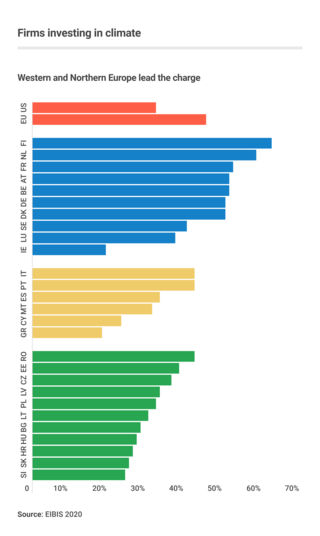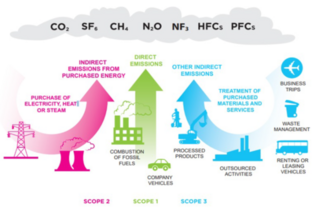Related Research Articles
The Clean Development Mechanism (CDM) is a United Nations-run carbon offset scheme allowing countries to fund greenhouse gas emissions-reducing projects in other countries and claim the saved emissions as part of their own efforts to meet international emissions targets. It is one of the three Flexible Mechanisms defined in the Kyoto Protocol. The CDM, defined in Article 12 of the Protocol, was intended to meet two objectives: (1) to assist non-Annex I countries achieve sustainable development and reduce their carbon footprints; and (2) to assist Annex I countries in achieving compliance with their emissions reduction commitments.

A carbon footprint (or greenhouse gas footprint) is a calculated value or index that makes it possible to compare the total amount of greenhouse gases that an activity, product, company or country adds to the atmosphere. Carbon footprints are usually reported in tonnes of emissions (CO2-equivalent) per unit of comparison. Such units can be for example tonnes CO2-eq per year, per kilogram of protein for consumption, per kilometer travelled, per piece of clothing and so forth. A product's carbon footprint includes the emissions for the entire life cycle. These run from the production along the supply chain to its final consumption and disposal.

Carbon offsetting is a carbon trading mechanism that enables entities such as governments or businesses to compensate for (i.e. “offset”) their greenhouse gas emissions by investing in projects that reduce, avoid, or remove emissions elsewhere. When an entity invests in a carbon offsetting program, it receives carbon credits. These "tokens" are then used to account for net climate benefits from one entity to another. A carbon credit or offset credit can be bought or sold after certification by a government or independent certification body. One carbon offset or credit represents a reduction, avoidance or removal of one metric Tonne of carbon dioxide or its carbon dioxide-equivalent (CO2e).

Business action on climate change includes a range of activities relating to climate change, and to influencing political decisions on climate change-related regulation, such as the Kyoto Protocol. Major multinationals have played and to some extent continue to play a significant role in the politics of climate change, especially in the United States, through lobbying of government and funding of climate change deniers. Business also plays a key role in the mitigation of climate change, through decisions to invest in researching and implementing new energy technologies and energy efficiency measures.
Flexible mechanisms, also sometimes known as Flexibility Mechanisms or Kyoto Mechanisms, refers to emissions trading, the Clean Development Mechanism and Joint Implementation. These are mechanisms defined under the Kyoto Protocol intended to lower the overall costs of achieving its emissions targets. These mechanisms enable Parties to achieve emission reductions or to remove carbon from the atmosphere cost-effectively in other countries. While the cost of limiting emissions varies considerably from region to region, the benefit for the atmosphere is in principle the same, wherever the action is taken.

Carbon accounting is a framework of methods to measure and track how much greenhouse gas (GHG) an organization emits. It can also be used to track projects or actions to reduce emissions in sectors such as forestry or renewable energy. Corporations, cities and other groups use these techniques to help limit climate change. Organizations will often set an emissions baseline, create targets for reducing emissions, and track progress towards them. The accounting methods enable them to do this in a more consistent and transparent manner.
Greenhouse gas inventories are emission inventories of greenhouse gas emissions that are developed for a variety of reasons. Scientists use inventories of natural and anthropogenic (human-caused) emissions as tools when developing atmospheric models. Policy makers use inventories to develop strategies and policies for emissions reductions and to track the progress of those policies.
The Global Warming Solutions Act of 2006, or Assembly Bill (AB) 32, is a California state law that fights global warming by establishing a comprehensive program to reduce greenhouse gas emissions from all sources throughout the state. AB32 was co-authored by Assemblymember Fran Pavley and Speaker of the California Assembly Fabian Nunez and signed into law by Governor Arnold Schwarzenegger on September 27, 2006.
The Gold Standard (GS), or Gold Standard for the Global Goals, is a standard and logo certification mark program, for non-governmental emission reductions projects in the Clean Development Mechanism (CDM), the Voluntary Carbon Market and other climate and development interventions. It is published and administered by the Gold Standard Foundation, a non-profit foundation headquartered in Geneva, Switzerland. It was designed with an intent to ensure that carbon credits are real, verifiable, and that projects make measurable contributions to sustainable development. The objective of the GS is to add branding, with a quality label, to carbon credits generated by projects which can then be bought and traded by countries that have a binding legal commitment according to the Kyoto Protocol, businesses, or other organizations for carbon offsetting purposes.

The United States produced 5.2 billion metric tons of carbon dioxide equivalent greenhouse gas (GHG) emissions in 2020, the second largest in the world after greenhouse gas emissions by China and among the countries with the highest greenhouse gas emissions per person. In 2019 China is estimated to have emitted 27% of world GHG, followed by the United States with 11%, then India with 6.6%. In total the United States has emitted a quarter of world GHG, more than any other country. Annual emissions are over 15 tons per person and, amongst the top eight emitters, is the highest country by greenhouse gas emissions per person. However, the IEA estimates that the richest decile in the US emits over 55 tonnes of CO2 per capita each year. Because coal-fired power stations are gradually shutting down, in the 2010s emissions from electricity generation fell to second place behind transportation which is now the largest single source. In 2020, 27% of the GHG emissions of the United States were from transportation, 25% from electricity, 24% from industry, 13% from commercial and residential buildings and 11% from agriculture.
Voluntary Emission Reductions or Verified Emission Reductions (VERs) are a type of carbon offset exchanged in the voluntary or over-the-counter market for carbon credits. Verified Emission Reductions are usually certified through a voluntary certification process.
The carboNZero programme and CEMARS programme are the world’s first internationally accredited greenhouse gas (GHG) certification schemes under ISO 14065. They provide tools for organisations, products, services and events to measure and reduce their greenhouse gas emissions, and optionally offset it. The programmes are owned and operated by Toitū Envirocare - Enviro-Mark Solutions Limited, a wholly owned subsidiary of Landcare Research.

Carbon emission trading (also called carbon market, emission trading scheme (ETS) or cap and trade) is a type of emission trading scheme designed for carbon dioxide (CO2) and other greenhouse gases (GHG). It is a form of carbon pricing. Its purpose is to limit climate change by creating a market with limited allowances for emissions. This can reduce the competitiveness of fossil fuels, and instead accelerate investments into renewable energy, such as wind power and solar power. Fossil fuels are the main driver for climate change. They account for 89% of all CO2 emissions and 68% of all GHG emissions.
ecosecurities is a company specialized in carbon markets and greenhouse gas (GHG) mitigation projects worldwide. ecosecurities specializes in sourcing, developing and financing projects on renewable energy, energy efficiency, forestry and waste management with a positive environmental impact.
Emissions reduction currency systems (ERCS) are schemes that provide a positive economic and or social reward for reductions in greenhouse gas emissions, either through distribution or redistribution of national currency or through the publishing of coupons, reward points, local currency, or complementary currency.
Territorialisation of Carbon Governance (ToCG) is a concept used in political geography or environmental policy which is considered to be a new logic of environmental governance. This method creates carbon-relevant citizens who become enrolled in the process of governing the climate. The territorialisation of carbon governance transforms climate change from a global to local issue. It embodies political practices that serve to connect the causes and consequences of global climate change to local communities.
Pedro Moura Costa is an entrepreneur involved in environmental finance with a focus on the international efforts for greenhouse gas (GHG) emission reductions. Of particular relevance, he was the founder and President of EcoSecurities Group Plc., one of the leading project developers for the international carbon markets, and has written widely about the policy and science of climate change mitigation, including contributions to the Intergovernmental Panel on Climate Change (IPCC) reports.
South Korea's Emissions Trading Scheme (KETS) is the second largest in scale after the European Union Emission Trading Scheme and was launched on January 1, 2015. South Korea is the second country in Asia to initiate a nationwide carbon market after Kazakhstan. Complying to the country's pledge made at the Copenhagen Accord of 2009, the South Korean government aims to reduce its greenhouse gas (GHG) emissions by 30% below its business as usual scenario by 2020. They have officially employed the cap-and-trade system and the operation applies to over 525 companies which are accountable for approximately 68% of the nation's GHG output. The operation is divided up into three periods. The first and second phases consist of three years each, 2015 to 2017 and 2018 to 2020. The final phase will spread out over the next five years from 2021 to 2025.
Global Carbon Council (GCC), formerly known as Global Carbon Trust (GCT), is MENA region's first voluntary carbon offsetting program. It facilitates global stakeholders in implementing climate actions through provision of voluntary carbon offsetting program.

Global net zero emissions describes the state where emissions of carbon dioxide due to human activities and removals of these gases are in balance over a given period. It is often called simply net zero. In some cases, emissions refers to emissions of all greenhouse gases, and in others it refers only to emissions of carbon dioxide. To reach net zero targets requires actions to reduce emissions. One example would be by shifting from fossil fuel energy to sustainable energy sources. Organizations often offset their residual emissions by buying carbon credits.
References
- ↑ "Offsety - Offset your personal emissions".
- ↑ McInerary, Sarah (April 26, 2009). "Eco Firm will pay Irish to Curb Carbon Usage". The Sunday Times. Archived from the original on 2010-08-03.
- ↑ Ashford, Lisa (August 17, 2009). "Charismatic Carbon Anyone?". Businessgreen.com/Carbon Offsets Daily.com.
- ↑ Fortifying the Foundation – State of the Voluntary Carbon Markets 2009 Archived 2009-11-22 at the Wayback Machine by Katherine Hamilton, et al. at Ecosystems Marketplace and New Carbon Finance, May 20, 2009 Chapter 7.
- ↑ "The Greenhouse Gas Protocol on Project Accounting by the World Business Council for Sustainable Development and the World Resources Institute" (PDF). Archived from the original (PDF) on 2009-05-21. Retrieved 2009-09-24.